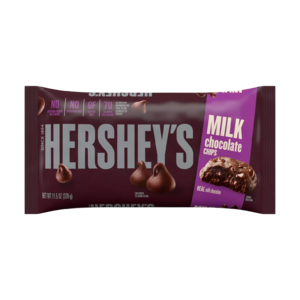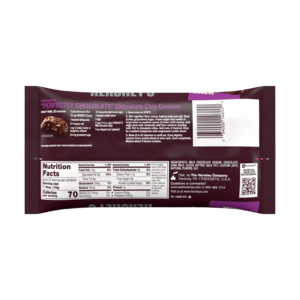Course:FNH200/Assignments/2024/Hershey's Chocolate Chips - Normal vs Sugar Free
Introduction
Hershey's Milk Chocolate Chips & Hershey's Zero Sugar Chocolate Chips
Hershey's Chocolate Chips are a popular baking ingredient that can be used in many recipes like chocolate chip cookies and chocolate chip muffins. There are many different versions such as sugar free or semi-sweet chocolate chips. A comparison between Hershey's Milk Chocolate Chips and Hershey's Zero Sugar Chocolate Chips will be made below to inform consumers of their choices.
Images of the Products
- See right side for four images of two products and their ingredients

Image 1A: Hershey's Milk Chocolate Chips 
Image 1B: Hershey's Milk Chocolate Chips Ingredients


Ingredient lists
- INGREDIENTS LIST:
- Hershey's Milk Chocolate Chips Ingredient List: Milk Chocolate (Sugar; Chocolate; Skim Milk; Cocoa Butter; Milk Fat; Lecithin (Soy); Natural Flavor)[1]
- Hershey's Zero Sugar Chocolate Chips Ingredient List: Maltitol; Chocolate Processed with Alkali; Cocoa Butter; Contains 2% or less of: Lecithin (Soy); Natural Flavor; Milk* (*Adds a negligible amount of sugar. Individuals sensitive to sugar may experience a laxative effect.)[2]
- SUGAR SUBSTITUTE AND ADDITIVES:
- ROLE OF SUBSTITUTES AND ADDITIVES:
- Maltitol is a digestible, low-calorie sugar alcohol sweetener that is a common sugar alternative for consumers who are diabetic or concerned with excess calories. They are 80% as sweet as sucrose[6], but only has 1.5-3 Cal per gram compared to sucrose, a carbohydrate, at 4 Cal per gram. Diabetic patients benefit due to its lack of glucose and insulin spike. However, they have laxative properties if consumed in high volumes, as stated on the ingredients list.[5]
- Lecithin is a commonly found phospholipid emulsifier. Emulsifiers are substances that allow for two liquids to mix. Phospholipids are a type of fat that have a water-loving (hydrophilic) head and a water-hating (hydrophobic) tail. The opposing properties of phospholipids allow for them to act as emulsifiers to create emulsions, a homogenous mix of two liquids that typically would not mix.[5]
- SIMILARITIES IN BOTH PRODUCTS:
- DIFFERENCES IN BOTH PRODUCTS:
- Although both have total carbohydrates at 9g, the breakdown of carbohydrates differs. The nutrition label of the regular chocolate package states that it includes 7g added sugars while the zero sugar package states that it includes 0 added sugars and introduces a new line for maltitol at 7g.[1][2]
- There is a 10 calorie difference per serving with the normal version containing 70 calories and the alternative containing 60. Notably, the zero sugar alternative has a 0.5g higher fat content (9 calories per gram; 4.5 calories for half a gram[4]) but low calories from using maltitol (1.5-3 calories per gram[5]) contributes to the lower caloric difference.
- The zero-sugar chocolate chips uses chocolate processed with alkali, which is less acidic, thus less bitter in taste[7]. Furthermore, the zero-sugar chocolate chip states that it 'contains 2% or less of' lecithin, natural flavor, and milk. The percentage indication is not written on the normal chocolate package.
- The regular chocolate chip package uses skim milk, and then uses milk fat further down on the ingredient list. Interestingly, the zero-sugar version does not detail their milk percentage.
- The zero-sugar alternative states that lactose, the sugar found in milk, 'adds a negligible amount of sugar.' It also warns of the laxative effect of sugar alcohols.
- The zero-sugar alternative declares allergens (soy and milk) under the ingredients list. The regular package, although it does contain both ingredients, have these allergens undeclared.
Labels
| Hershey's Milk Chocolate Chips & Hershey's Zero Sugar Chocolate Chips | |
|---|---|
| Common Name | It is commonly known as Hershey's Milk Chocolate Chips and Hershey's Zero Sugar Chocolate Chips |
| Bilingualism | Both of the products only offer English labels as the packaging in these pictures are from the country of origin, the United States. However, the Canadian version of the product must adhere to labelling regulations that will include both English and French for the core labels. [8] |
| Country of Origin | This does not apply for this food product so it is not on the labels. |
| Date Markings & Storage Instructions | There is an ink stamped "BB" or "Best By" date code on both Hershey's chocolate chips product.
Products should be kept in room temperature, about 55-60°F. It not recommended to store in the fridge but safe to do so. The shelf life is about 1 year after opening. There will be flavour loss or texture change after about 1 year. |
| Name & Principal Place of Business | The principal place of business is in Pennsylvania, United States. |
| Legibility & Location | The back of the packaging, Images 1B and 2B, have clear labels regarding ingredients and nutritional information. |
| Net Quantity | The net weight for the Hershey's Milk Chocolate Chip's is 11.5 oz (326 grams) it is shown on the bottom left of the front label.
The net weight for the Hershey's Zero Sugar Chocolate Chips is 8oz (226.8 grams) It is also shown on the bottom left of the front label. |
| Nutrition Facts | Hershey's Milk Chocolate Chips
Can be seen in images 1B and 2B. |
| Irradiation | N/A |
| List of Ingredients and Allergens |
|
| Sweeteners | Hershey's Zero Sugar Chocolate Chips: Maltitol |
| Food Additives | Hershey's Milk Chocolate Chips: Lecithin
Hershey's Zero Sugar Chocolate Chips: Maltitol, lecithin |
| Claim and Statements | The front of both packages (images 1A and 2A) state that they contain:
|
References
- ↑ 1.0 1.1 1.2 Hersheyland. "Hersheys Milk Chocolate Chips".
- ↑ 2.0 2.1 2.2 Hersheyland. "Hersheys Sugar Free Chocolate Chips".
- ↑ Wiki, UBC. "UBC Wiki FNH 200 Lesson 2.2.1.1 Carbohydrates".
- ↑ 4.0 4.1 Wiki, UBC. "UBC Wiki FNH 200 Lesson 2.2.1.2 Fats".
- ↑ 5.0 5.1 5.2 5.3 "UBC Wiki Lesson 3.1 Fat and Sugar Substitutes".
- ↑ BeMiller, James (2019). "Carbohydrate and Noncarbohydrate Sweeteners". Carbohydrate Chemistry for Food Scientists (Third Edition) – via Science Direct.
- ↑ Wikipedia. "Dutch Process Cocoa".
- ↑ Canadian Food Inspection Agency. "Bilingual Food Labelling".
| This Food Science resource was created by Course:FNH200. |


